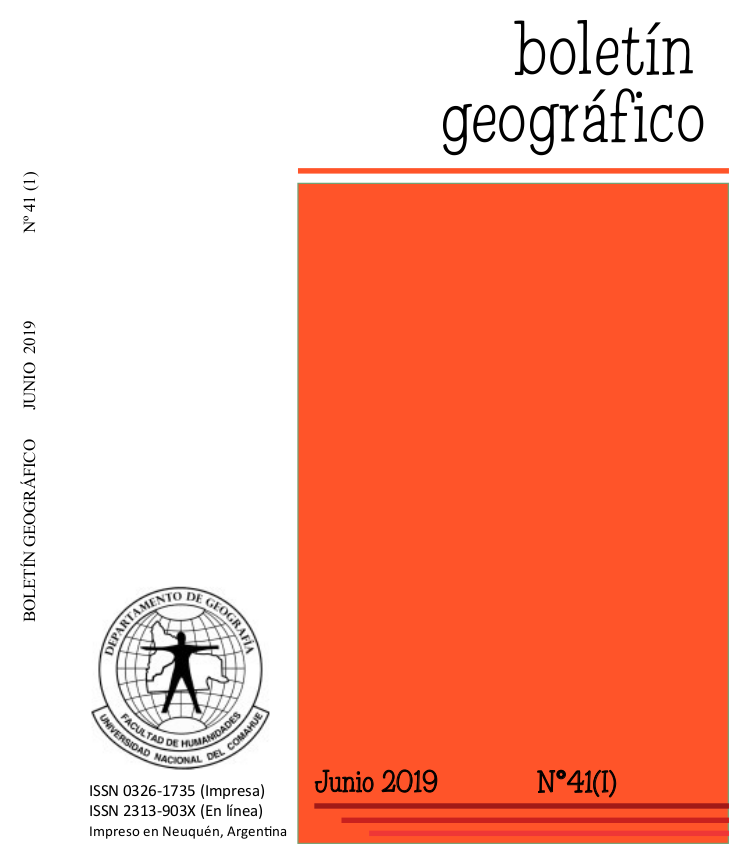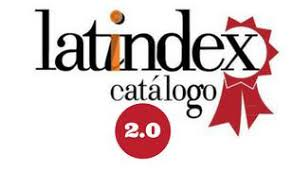Influencia de factores edafo/climáticos sobre poblaciones microbianas de suelos áridos con agricultura bajo riego
Palabras clave:
Actividad biológica, Riego, Ecosistemas áridosResumen
Lasfronterasagrícolas se están expandiendoconstantemente,por medio de la tecnología de riego,haciazonas áridas marginales. Considerando el impacto de la población bacteriana y su actividad biológica en la homeostasis del suelo, lageneración deinformación sobre la biodiversidad del suelo y su actividad biológica son un importante aporte para maximizar la producción con un impacto mínimo en estos ambientes susceptibles. El objetivo de este trabajo exploratorio fue evaluar el efecto de las prácticas agrícolas a largo plazo (30 años) sobre la actividad y los aspectos estructurales de la comunidad microbiana de los suelos áridoscon agricultura bajo riego. Para ello, seevaluaron tres ambientes, recolectandomuestras de un suelo árido Prístino (sin riegoy sin disturbar) y dos suelos agrícolasbajo riego con diferentehistorial de manejo(Alfalfa y Maíz) a lo largo de la temporada 2014-2015. Se realizóunanálisis fisicoquímico delossuelos, se registró la temperatura y humedad, así como la actividad biológica total (hidrólisis FDA) y la huella molecular (DGGE y T-RFLP) para cada tratamiento. Los análisis fisicoquímicos del suelo muestran que las prácticas agrícolas mejoraronalgunas de laspropiedades edáficas como el nivel de materia orgánica, aunque el aporte de agua en cantidades limitadas (riego presurizado)provocóun aumento de la conductividad eléctrica. La actividad biológica total a lo largo de las estacionesdel añomostró perfiles similares para todos los ambientes, y los meses más fríos/sin riego y más caluroso/con riegomostraron las actividades más bajas y más altas, respectivamente. En general, la condición Prístinapresentó niveles de actividad biológica significativamente más bajos a lo largo de la temporada. La huella dactilar DGGE mostró un patrón discreto con bajonúmero de bandas y, contra lo esperado, no mostró diferencias entre los tres ambientes evaluados.El análisisporT-RFLP posterior confirmó que la biodiversidad bacteriana del suelo no fue modificada por décadas de intensa actividad agrícola.
Descargas
Citas
Abbasi, K.M., Zafar, M. & Sultan, T. (2010). Changes in soil properties and microbial indices across various management sites in the mountain environments of Azad Jammu and Kashmir Commun. Soil science and plant analysis. 41, 768-782.
Adam, G. & Duncan, H. (2001). Development of a sensitive and rapid method for the measurement of total microbial activity using fluorescein diacetate (FDA) in a range of soils. Soil biology and biochemistry. 33, 943-951.
Agaras, B.C., Wall, L.G.& Valverde, C. (2014). Influence of agricultural practices and seasons on the abundance and community structure of culturable pseudomonads in soils under no-till management in Argentina. Plant soil 379: DOI 10.1007/s11104-014-20958.
Bach, E.M., Baer, S.G., Meyer, C.K., Six, J. (2010). Soil texture affects soil microbial and structural recovery during grassland restoration. Soil biology and biochemistry. 42, 2182-2191.
Babin, D., Vogel, C., Zühlke, S., Schloter, M., Pronk, G.J., Heister. K., Spiteller, M., Kögel-Knabner, I., Smalla, K. (2014). Soil mineral composition matters: response of microbial communities to phenanthrene and plant litter addition in long-term matured artificial soils. PLoS ONE 9, 1-12.
Bevivino, A., Paganin, P., Bacci, G., Florio, A., Pellicer, M.S., Papaleo, M.C., Mengoni, A., Ledda, L., Fani, R., Benedetti, A., Dalmastri, C., 2014. Soil Bacterial Community Response to Differences in Agricultural Management along with Seasonal Changes in a Mediterranean Region. PLoS ONE 9(8): e105515. doi:10.1371/journal.pone.0105515
Boerner, R.E.J., Brinkman, J.A. & Smith, A. (2005). Seasonal variations in enzyme activity and organic carbon in soil of a burned and unburned hardwood forest. Soil Biology & Biochemistry 37, 1419–1426.
Bouyoucos, G., 1962 Hydrometer method improved for making particle size analysis of soils. Agronomy Journal. 54, 464-465.
Burke, I.C., Yonker, C.M., Parton, W.J., Cole, C.V., Flach, K., Schimel, D.S. (1989). Texture, Climate, and Cultivation Effects on Soil Organic Matter Content in U.S. Grassland Soils. Soil Science Society of America Journal. 53, 800-805.
Carbonetto, B., Rascovan, N., Alvarez, R., Mentaberry, A., Vázquez, M.P. (2014). Structure, composition and metagenomic profile of soil microbiomes associated to agricultural land use and tillage systems in Argentine pampas. PLoS ONE. 9(6): e99949. doi:10.1371/journal.pone.0099949.
del Valle, H.F. (1998). Patagonian soils: a regional synthesis. Ecología Austral. 8, 103-123.
Drenovski, R.E., Vo, D., Graham, K.J., Scow, K.M. (2004). Soil water content and organic carbon availability are major determinants of soil microbial community composition. Microbial Ecology. 48, 424–430.
Duncan, D. B. (1955). Multiple Range and Multiple F Tests. Biometrics, 11(1), 1–42. https://doi.org/10.2307/3001478
Entry, J.A., Mills, DE., Mathee, K., Jayachandran, K., Sojka, RE., Narasimhan, G. (2008). Influence of irrigated agriculture on soil microbial diversity. Applied Soil Ecology. 40: 146-154.
Enwall, K.& Hallin, S. (2009). Comparison of T-RFLP and DGGE techniques to assess denitrifier community composition in soil. Letters in Applied. Microbiology. 48, 145–148.
Evans, R.G.& Sadler, E.J. (2009). Methods and technologies to improve efficiency of water use. Water Resources Research. 44. doi:10.1029/2007WR006200.
Fang, M., Kremer, R.J., Motavalli, P.P., Davis, G. (2005). Bacterial diversity in rhizospheres of nontransgenic and transgenic corn. Applied and Environmental Microbiology. 71, 4132–4136.
Figuerola, E.L.M., Guerrero, L.D., Rosa, S.M., Simonetti, L., Duval, M.E., Galantini, J.A., Bedano, J.C., Wall, L.G., Erijman, L. (2012). Bacterial indicator of agricultural management for soil under no-till crop production. PLoS ONE 7(11): e51075. doi:10.1371/journal.pone.0051075.
Francioli, D., Ascher, J., Ceccherini, M.T., Pietramellara, G. (2014). Land use and seasonal effects on a Mediterranean soil bacterial community. Journal of Soil Science and Plant Nutrition. 14, 710-722.
Furrer Chau, J., Bagtzoglou, A.C. & Willig, M.R. (2011). The effect of soil texture on richness and diversity of bacterial communities. Environmental. Forensics, 12, 333–341.
Gabriel, J.L., Almendros, P., Hontoria, C., Quemada, M., 2012. The role of cover crops in irrigated systems: Soil salinity and salt leaching. Agriculture, Ecosystems & Environment. 158, 200-207.
Garbeva, P., van Veen, J.A. & van Elsas, J.D. (2004). Microbial Diversity in Soil: Selection of Microbial Populations by Plant and Soil Type and Implications for Disease Suppressiveness. Annual Review of Phytopathology. 42, 243–70.
Green, V.S., Stott, E.D.& Diack, M. (2006). Assay for fluorescein diacetate hydrolytic activity: Optimization for soil samples. Soil Biology & Biochemistry 38, 693–701.
Griffiths, B.S., Bonkowski, M., Roy, J. & Ritz, K. (2001). Functional stability, substrate utilization and biological indicators of soils following environmental impacts. Applied Soil Ecology. 16, 49–61.
Hamarashid, N.H., Othman, M.A. & Hussain, M-A.H. (2010). Effects of soil texture on chemical compositions, microbial populations and carbon mineralization in soil. Egyptian journal of experimental biology. 6: 59 – 64.
Kuramae, E.E., Yergeau, E., Wong, L.C., Pijl, A.S., van Veen, J.A., Kowalchuk, G.A. (2012). Soil characteristics more strongly influence soil bacterial communities than land-use type. FEMS Microbiology Ecology. 79, 12–24.
Li, X. & Sarah, P., 2003. Enzyme activities along a climatic transect in the Judean Desert. Catena 53, 349-363.
Matson, P.A., Parton, W.J., Power, A.G., Swift, M.J. (1997). Agricultural Intensification and Ecosystem Properties. Science. 277, 504-509.
Meena, V.S., Maurya, B.R., Meena, R.S., Meena, S.K., Singh, N.P., Malik, V.K., Kumar, V., Jat, L.K. (2014). Microbial dynamics as influenced by concentrate manure and inorganic fertilizer in alluvium soil of Varanasi, India. African Journal of Microbiology Research. 8, 257-263.
Mendham, D.S., Sankaran, K.V., O'Connell, A.M., Grove, T.S. (2002). Eucalyptus globulus harvest residue management effects on soil carbon and microbial biomass at 1 and 5 years after plantation establishment. Soil Biol. Biochem. 34, 1903-1912.
Mohd-Aizat, A., Mohamad-Roslan, M.K., Sulaiman W.N.A., Karam, D.S. (2014). The relationship between soil pH and selected soil properties in 48 years logged-over forest. International Journal of Environmental Science. 4, 1129-1140.
Naether, A., Foesel, B.U., Naegele, V., Wüst, P.K., Weinert, J., Bonkowski, M., Alt, F., Oelmann, Y., Polle, A., Lohaus, G., Gockel, S., Hemp, A., Kalko, E.K.V., Linsenmair, K.E., Pfeiffer, S., Renner, S., Schöning, I., Weisser, W.W., Wells, K., Fischer, M., Overmann, J., Friedricha, M. W. (2012). Applied and Environmental Microbiology. 78, 7398–7406.
Panigatti, J.L. (2010). Argentina: 200 años, 200 suelos. Ediciones INTA, Buenos Aires.
Pérez, A.J., Abrahao, R., Causape, J; Cirpka, O.A., Burger, C.M. (2011). Simulating the transition of a semi-arid rainfed catchment towards irrigation agriculture. Journal of Hydrology. 409, 663-681.
Rattan L. (1993). Tillage effects on soil degradation, soil resilience, soil quality, and sustainability. Soil and Tillage Research. 27, 1-8.
Scanlon, B.R., Jolly, I., Sophocleous, M., Zhang, L. (2007). Global impacts of conversions from natural to agricultural ecosystems on water resources: Quantity versus quality. Water Resources. Research. 43, 1-18.
Schnürer, J. & Rosswall, T. (1982). Fluorescein diacetate hydrolysis as a measure of total microbial activity in soil and litter. Appl. Environ. Microbiol. 43, 1256-1261.
Singh, B.K., Munro, S., Reid, E., Ord, B., Potts, J.M., Paterson, E., Millard, P. (2006). Investigating microbial community structure in soils by physiological, biochemical and molecular fingerprinting methods. European Journal of Soil Science. 57, 72–82.
Smith, C.J., Danilowicz, B.S., Clear, A.K., Costello, F.J., Wilson, B., Meijer, W.G. (2005). T-Align, a web-based tool for comparison of multipleterminal restriction fragment length polymorphism profiles. FEMS Microbiology Ecology. 54, 375–380.
Smithwick, E.H.A., Turner, M.G., Metzger, K.L., Balser, T.C. (2005). Variation in NH4+ mineralization and microbial communities with stand age in lodgepole pine (Pinus contorta) forests, Yellowstone National Park (USA). Soil Biology and Biochemistry. 37, 1546-1559.
Solaiman, Z. & Marschner, P. (2007). DGGE and RISA protocols for microbial community analysis in soil. In: Advanced techniques in soil microbiology (Varma, A. & Oelmüller, R., eds.), Springer-Verlag, Berlin Heidelberg, 167–180.
Şumalan, R., Alexa, E., Negrea, M., Doncean, A. (2010). Comparative study on biological activity and edaphic microflora composition for four soil types from SDE Timisoara. Research Journal of Agricultural Sciences. 42, 324-327.
Tabuchi, H., Kato, K.& Nioh, I. (2008). Season and soil management affect soil microbial communities estimated using phospholipid fatty acid analysis in a continuous cabbage (Brassica oleracea var. capitata) cropping system. Soil Science and Plant Nutrition. 54, 369-378.
Tilman, D. (1999). Global environmental impacts of agricultural expansion: The need for sustainable and efficient practices. Proceedings of the. National. Academy of Sciences. USA 96, 5995–6000.
Torsvik, V. & Ovreas, L. (2002). Microbial diversity and function in soil: from genes to ecosystems. Current Opinion in Microbiology. 5, 240–245
Walkley, A. & Black, I.A. (1934). An examination of the Degtjareff method for determining soil organic matter, and proposed modification of the chromic acid titration method. Soil Science 37, 29-38.
Weisburg, G.W., Barns, S.M., Pelletier, D.A. Lane, D.J. (1991). 16S ribosomal DNA amplification for phylogenetic study. Journal of. Bacteriology. 173, 697-703.
You, Y., Wang, J., Huang, X., Tang, Z., Liu, S., Sun, O.J. (2014). Relating microbial community structure to functioning in forest soil organic carbon transformation and turnover. Ecology and Evolutiol. 4, 633-647.
Zelles, R., Rackwitz, O., Yo Bai, T., Beck, I., Beese, F. (1995). Discrimination of microbial diversity by fatty acid profiles of phospholipids and lipopolysaccharides in differently cultivated soils. Plant Soil. 170, 115-122.
Zhao, J., Ni, T., Li, Y., Xiong, W., Ran, W., Shen, B., Shen, Q., Zhang, R. (2014). Responses of bacterial communities in arable soils in a rice-wheat cropping system to different fertilizer regimes and sampling times. PLoS ONE 9(1): e85301.
doi:10.1371/journal.pone.0085301.
Ziesemer, K., Mann, A., Sankaranarayanan, K. et al. (2015). Intrinsic challenges in ancient microbiome reconstruction using 16S rRNA gene amplification. Scientific. Reports. 5, 1649
Descargas
Publicado
Cómo citar
Número
Sección
Licencia
Derechos de autor 2021 Boletín GeográficoLa aceptación de colaboraciones por parte de la revista implica la cesión no exclusiva de los derechos patrimoniales de los autores a favor del editor, quien permite la reutilización bajo Licencia Atribución-NoComercial-SinDerivadas 2.5 Argentina (CC BY-NC-ND 2.5 AR)
Usted es libre de:
Compartir — copiar y redistribuir el material en cualquier medio o formato
La licenciante no puede revocar estas libertades en tanto usted siga los términos de la licencia
Bajo los siguientes términos:
Atribución — Usted debe dar crédito de manera adecuada, brindar un enlace a la licencia, e indicar si se han realizado cambios. Puede hacerlo en cualquier forma razonable, pero no de forma tal que sugiera que usted o su uso tienen el apoyo de la licenciante.
NoComercial — Usted no puede hacer uso del material con propósitos comerciales.
SinDerivadas — Si remezcla, transforma o crea a partir
El simple hecho de cambiar el formato nunca genera una obra derivada, no podrá distribuir el material modificado.
No hay restricciones adicionales — No puede aplicar términos legales ni medidas tecnológicas que restrinjan legalmente a otras a hacer cualquier uso permitido por la licencia.
La cesión de derechos no exclusivos implica también la autorización por parte de los autores para que el trabajo sea alojado en el repositorio institucional y difundido a través de las bases de datos que el editor considere apropiadas para su indización, con miras a incrementar la visibilidad de la revista y sus autores.
FORMULARIO DE CESIÓN DE DERECHOS DE AUTOR


















